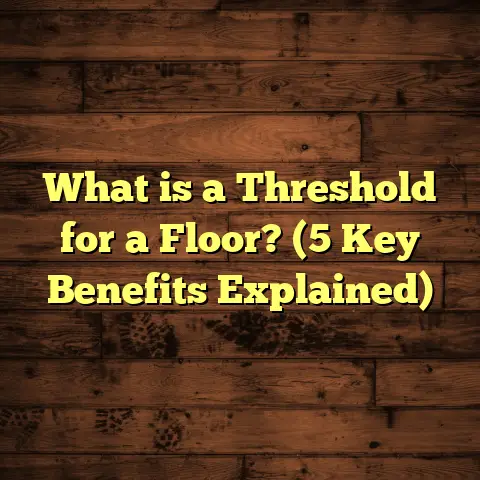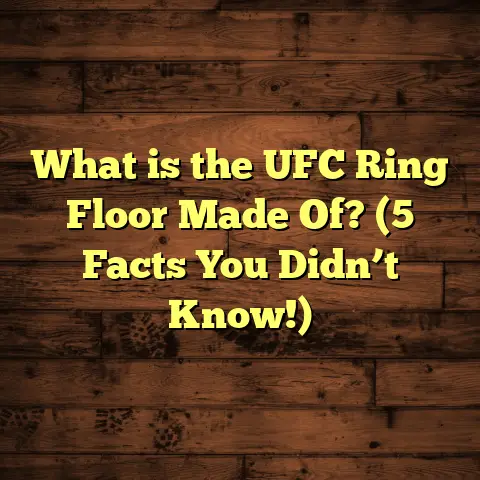What is Terrazzo Floor? (5 Key Materials Explained)
Have you ever walked into a building and been struck by the floor? Not just because it looked nice, but because it seemed like a piece of art under your feet? That’s the magic of terrazzo floors. I’ve been in the flooring business for years, working with everything from hardwood to vinyl, but terrazzo always fascinates me. It’s not just a floor; it’s an experience that combines durability, style, and history.
So, what is terrazzo floor? Let me break it down for you. Terrazzo is a composite flooring material made by mixing chips of marble, quartz, granite, glass, or other aggregates with a binder such as cement or epoxy. After the mixture is poured, it’s ground and polished to a smooth, shiny finish. This technique originated centuries ago but has evolved with modern materials and methods.
In this article, I want to share everything I know about terrazzo floors—especially focusing on the five key materials that make it up—and sprinkle in my personal experiences and industry insights along the way. Whether you’re thinking about installing terrazzo or just curious about what makes it special, you’ll find plenty of useful information here.
What Exactly Is Terrazzo?
If you asked me ten years ago to describe terrazzo in one sentence, I’d say: “It’s like a giant mosaic floor made from tiny pieces of stone and other materials set in concrete or epoxy.” But over time, I’ve come to appreciate how complex and customizable terrazzo really is.
The word terrazzo comes from the Italian word for “terrace” because these floors were originally used on outdoor terraces in Venice during the 15th century. Craftsmen would recycle leftover marble chips from cutting workshops by embedding them into clay surfaces, creating floors that were both beautiful and durable.
Today, terrazzo floors have gone beyond their origins. They’re used in airports, museums, schools, hospitals—you name it. And homeowners are choosing terrazzo more than ever because it offers:
- Longevity: Terrazzo floors can last 40-50 years or more.
- Design flexibility: You can mix colors and aggregates to create custom patterns.
- Low maintenance: Properly sealed terrazzo resists stains and is easy to clean.
- Eco-friendliness: Recycled aggregates like glass reduce environmental impact.
- Durability: Resistant to heavy foot traffic and wear.
When I first started working with terrazzo, I was amazed at how many options there were to customize colors and textures. Some clients want classic white marble chips embedded in gray cement for a vintage look. Others want bold colored glass chips set in epoxy for a modern statement floor.
What’s fascinating is how all these variations come from combining just five key materials.
The Five Key Materials Used in Terrazzo Flooring
I want to take you through each of these ingredients one by one. Knowing what goes into your terrazzo floor helps you make better decisions, whether you’re installing new floors or repairing old ones.
1. Aggregates: The Visual Heartbeat of Terrazzo
Aggregates are the small chips or particles you see embedded in terrazzo floors. They’re what give terrazzo its unique speckled look—like walking on something natural yet artistic.
You might be familiar with marble chips since they’re the traditional choice. But aggregates can include:
- Marble chips (classic choice)
- Quartz (adds sparkle and hardness)
- Granite (for durability)
- Glass (recycled glass adds color and sustainability)
- Metal flakes (aluminum or brass for shine)
- Other natural stones
When I first installed terrazzo floors in a commercial building downtown, we opted for a mix of marble and recycled glass chips. The client loved how the glass gave the floor a subtle shimmer under natural light. It was also a great eco-friendly decision—something that’s increasingly important today.
Size matters too. Chips usually range from 1/8 inch to 1/4 inch in diameter. Smaller chips create a fine-grained look; larger chips add texture and visual interest. In one hospital project I worked on, we used smaller chips because they help prevent dirt from getting trapped, making cleaning easier.
Here’s an interesting data point: according to the National Terrazzo & Mosaic Association (NTMA), marble aggregates constitute about 60-80% of the total volume in traditional terrazzo mixtures. This high percentage is why terrazzo floors are so strong and resilient.
2. Binder: The Foundation That Holds It All Together
The binder is what glues those beautiful chips in place. There are two main types:
- Cementitious binder (traditional Portland cement)
- Epoxy resin binder
Each has its pros and cons.
Cement-based terrazzo has been used for centuries. It’s breathable—meaning it allows moisture to escape—and extremely durable outdoors or indoors. It requires longer curing times (sometimes weeks) but can withstand heavy foot traffic and weather changes.
Epoxy-based terrazzo is a modern alternative made from synthetic resins mixed with hardeners. It cures much faster (within days), offers more color options since pigments mix easily with resin, and provides a smoother finish. However, epoxy is sensitive to UV rays and can yellow or degrade if used outdoors without protection.
I remember a project where a client wanted terrazzo on their outdoor patio using epoxy resin because of its vibrant colors. I advised against it since exposure to sun would cause fading and damage over time. Instead, we chose cement-based terrazzo with pigment dyes to meet their needs.
The mechanical properties are worth mentioning:
- Epoxy terrazzo typically has compressive strength around 8,000–12,000 psi.
- Cementitious terrazzo ranges from 4,000–6,000 psi but is more resistant to weathering.
3. Reinforcement Mesh: Strengthening the Structure
Reinforcement mesh acts like a skeleton inside your terrazzo slab, preventing cracks caused by building movement or settling.
This mesh is typically made from:
- Steel wire mesh
- Fiberglass mesh
Depending on the project size and substrate conditions, reinforcement can be critical.
In one office building renovation I managed, the original terrazzo was cracked due to lack of reinforcement combined with a shifting foundation. We included a galvanized steel mesh this time around, which dramatically improved floor durability.
Not all contractors mention this detail upfront, but it makes a big difference—especially for large areas or places prone to temperature fluctuations or vibrations.
4. Divider Strips: The Artists’ Lines
Divider strips are thin metal strips placed before pouring the terrazzo mixture. They serve multiple purposes:
- Create design patterns by separating colors or textures
- Act as expansion joints preventing cracking
- Help control shrinkage during curing
Most divider strips are aluminum or brass but sometimes stainless steel is used for long-lasting performance.
Think of divider strips as the outlines you see when coloring inside a coloring book. Without them, different color zones would bleed into each other and cause uneven edges.
I once designed an elaborate geometric pattern using divider strips for a museum lobby floor. The strips allowed us to pour different colored mixes precisely without any overlap or mess.
5. Sealer: The Protective Layer
After polishing your terrazzo floor to that gorgeous shine, sealing it is essential for protection. Sealers guard against stains, water penetration, and wear while enhancing colors.
There are two main types of sealers:
- Penetrating sealers soak into pores without altering the floor’s appearance.
- Film-forming sealers create a thin protective layer on top but may wear off faster.
In my experience, penetrating sealers provide better longevity without changing the matte or gloss finish significantly. For high-traffic commercial areas, I recommend reapplying sealers every 1-3 years to maintain protection.
Tips From My Years Working With Terrazzo Floors
If you’re considering terrazzo flooring or just curious about maintenance and installation, here are some practical pointers I’ve picked up:
Choose Your Aggregates Thoughtfully
Your choice affects aesthetics and function. For example:
- Marble chips offer timeless elegance but can be slippery when polished.
- Glass aggregates sparkle but may show scratches more easily.
- Quartz adds hardness but can be costly.
For homes with kids or pets, I often recommend medium-sized marble chips combined with quartz for durability plus style.
Understand Your Project Environment
Will your floor be indoors or out? Terrazzo outdoors faces weather challenges like UV rays and moisture. Cement-based mixes handle this well; epoxy doesn’t.
Also consider foot traffic volume:
- High traffic areas like airports benefit from dense cementitious terrazzo.
- Residential spaces can use epoxy for vibrant colors with less wear concerns.
Hire Experienced Installers
I can’t stress this enough: terrazzo installation is a craft. Mixing ratios must be precise; curing needs patience; polishing requires skill.
A poorly installed terrazzo floor ends up uneven or cracked fast. On one job site, we had to redo an entire floor after the first contractor rushed curing times causing delamination.
Maintenance: Simple But Important
Daily cleaning involves sweeping grit away and mopping with neutral pH cleaners only—no acids or harsh chemicals!
Spills should be wiped immediately to prevent staining despite sealing.
Budget Wisely
Terrazzo can be pricier than some other flooring options initially—expect $20-$50 per square foot depending on material choices and design complexity.
However, its lifespan often exceeds 40 years with minimal upkeep costs—making it cost-effective long-term compared to hardwood or carpet replacements every decade.
Real Data and Insights About Terrazzo Flooring
Here are some numbers that might surprise you:
| Factor | Terrazzo | Hardwood Floor | Vinyl Flooring |
|---|---|---|---|
| Average Lifespan | 40+ years | 15-30 years | 5-10 years |
| Maintenance Cost Over 10 yrs | Low ($500-$1,000) | Medium ($2,000-$3,000) | Medium ($1,500-$2,000) |
| Compressive Strength (psi) | 4,000–12,000 | ~1,100 | ~500 |
| Water Resistance | High (with sealer) | Medium | High |
| Environmental Impact | Uses recycled aggregates | Uses trees | Synthetic materials |
Data from NTMA & Flooring Industry reports show terrazzo floors have lower lifetime costs despite higher upfront prices due to durability and low maintenance needs.
Case Study: Commercial Office Lobby Terrazzo Installation
Let me share one detailed project story that illustrates everything I’ve talked about:
A downtown office wanted a durable yet stylish lobby floor that could handle thousands of daily visitors without losing its shine.
We recommended epoxy-based terrazzo for vibrant color options matching their brand palette combined with recycled glass aggregates for sparkle plus green credentials.
Key steps included:
- Preparing concrete substrate with reinforcement mesh to prevent cracking.
- Installing brass divider strips outlining geometric sections reflecting company logo.
- Pouring epoxy binder mixed with aggregates in each section carefully.
- Grinding progressively with diamond polishing pads until smooth.
- Applying penetrating sealer twice for stain resistance.
- Final buffing for gloss finish.
Result? The lobby floor lasted through heavy foot traffic for over five years without dulling or cracks and became a talking point among visitors—a perfect blend of function and design.
Personal Reflections on Terrazzo Floors
Over years in flooring work, I’ve gained a deep appreciation for terrazzo’s blend of craftsmanship and science. It requires patience—curing times can test your schedule—but rewards you with floors that tell stories through their patterns and materials.
One thing I love sharing with clients is how their floor isn’t just something underfoot—it’s part of their space’s personality. The choice of marble colors reminds me of their favorite places; recycled glass hints at their eco values; divider strip patterns echo their style preferences.
If you decide on terrazzo flooring yourself, think about what story your floor will tell.
How To Get Started With Your Terrazzo Project
If you’re ready to explore terrazzo further:
- Research local contractors who specialize in terrazzo installation.
- Gather samples of aggregates and binders to see what appeals most.
- Use online calculators like FloorTally to estimate costs based on square footage and material choices.
- Visit completed projects if possible to experience terrazzo firsthand.
- Discuss maintenance plans upfront to protect your investment long-term.
Final Thoughts Without Saying “In Conclusion”
Terrazzo flooring is truly an investment—in beauty, longevity, and unique style. Its components—from aggregates to sealers—all work together to create floors that last decades while remaining easy on upkeep.
If you ever get the chance to own or work on a terrazzo floor project, grab it! You’ll gain not only stunning aesthetics but also floors built tough enough to handle life’s demands gracefully.
If you want advice on selecting materials or finding trusted installers near you or help calculating project costs using tools like FloorTally based on your specific needs—just ask! I’m here to help turn your flooring ideas into reality.





